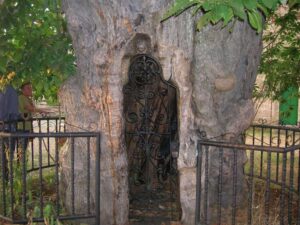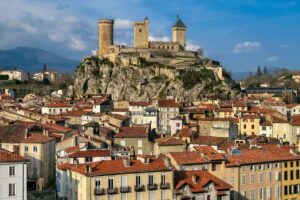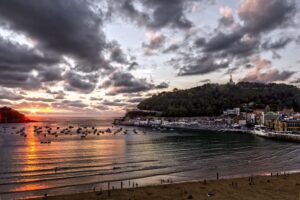
A Caridad, the capital of the municipality of El Franco, in the western part of Asturias, is a key stop for pilgrims on the Camino del Norte. This coastal town, with its tranquil atmosphere, offers a well-deserved rest and the opportunity to immerse oneself in the authenticity of rural and maritime Asturias.
Its location makes it an essential stop for those looking to recharge and enjoy the beauty of the landscape before continuing their journey to Santiago de Compostela. But before we tell you about everything you’ll see here, let us first introduce you to the Camino del Norte, the route that passes through the town.
Índice de contenidos
The Camino del Norte: A route of contrasts and unmatched beauty
The Camino de Santiago offers a variety of routes that cater to every pilgrim.
For those seeking an experience where nature, culture, and history intertwine with coastal and mountainous landscapes, the Camino del Norte stands as an unrivalled option.
This route, which runs along the northern coastline, is a true delight for the senses. It offers spectacular views of the sea, cliffs, secluded beaches, and lush valleys that stretch inland.
Its landscape richness is one of its main attractions. It allows pilgrims to enjoy the sea breeze and the scent of saltwater while walking along paths that wind through fishing villages and dense forests.
From the majesty of the Galician coast, with starting points like the Camino del Norte from Ribadeo, to the vibrant culture of the Basque Country, with routes starting like the Camino de Santiago from Bilbao, each stage is an opportunity to discover the diverse geography of northern Spain.
Unlike other routes, such as the Camino Portugués from Tui, it is distinguished by its lower levels of mass tourism and the authenticity of its villages. This allows for a deeper connection with the environment and the essence of pilgrimage.
The possibility of receiving support from a Camino de Santiago agency makes planning and enjoying this adventure easier. They take care of aspects like accommodation and luggage transport, allowing pilgrims to focus on the experience.
A Caridad: A haven of peace on the Camino
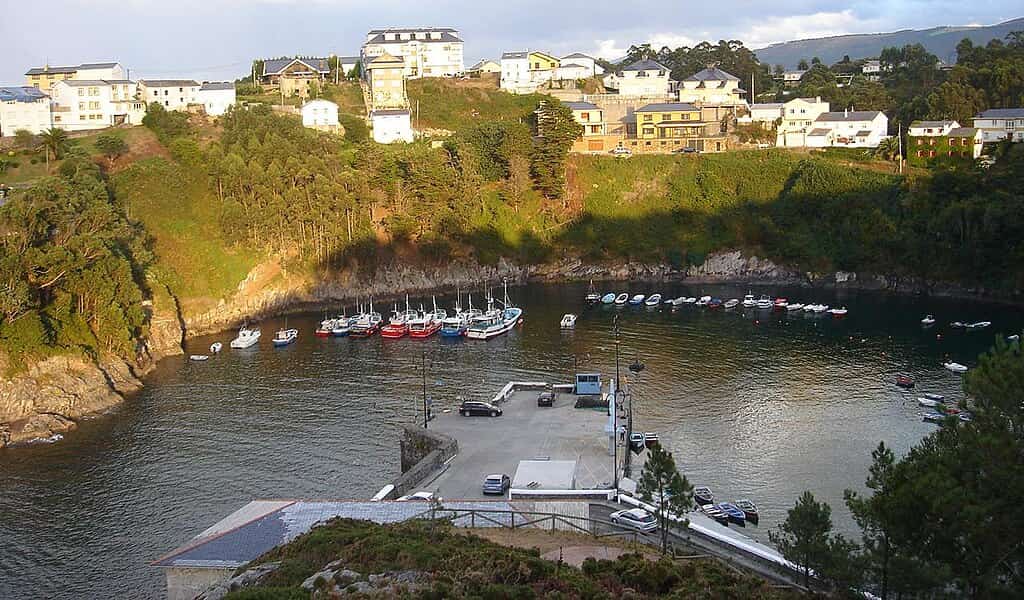
A Caridad, with its welcoming atmosphere, offers pilgrims an ideal place to rest and regain strength. While it is true that it is not a town known for grand monuments, its charm lies in the authenticity of everyday life and the friendliness of its people. The pilgrim will find here a place where tranquility and simplicity take centre stage.
Points of interest for pilgrims
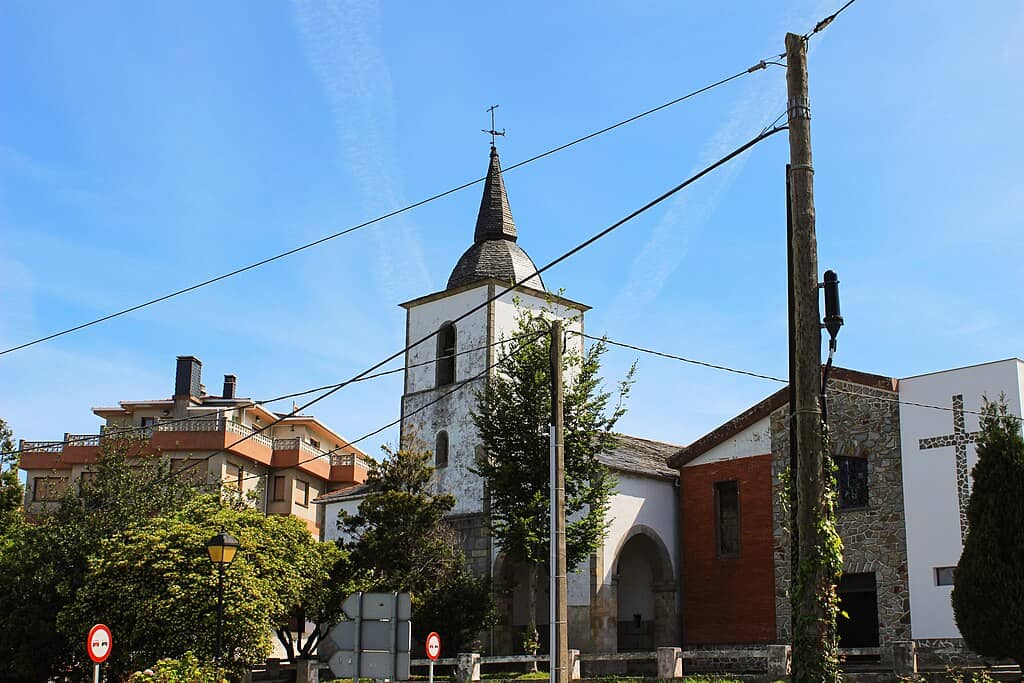
The main point of interest for pilgrims in A Caridad is its Pilgrim’s Hostel, a fundamental place for socialising. This hostel not only offers a roof and a bed but also a meeting space where pilgrims can share experiences, advice, and anecdotes from the Camino.
The Church of San Miguel de Mohíces, although modest in size, is a good example of local religious architecture and a space for reflection and spiritual retreat. Its simplicity and deep-rooted presence in the community make it an important place for many pilgrims.
A stroll through the Maria Cristina Park, with its emotional monument to emigrants, offers a moment of calm and a chance to observe local life. This park is the heart of the town, perfect for a brief rest or to stretch your legs after a long day’s walk.
Despite its size, it has essential basic services (food stores, pharmacies, and several restaurants and bars).
Gastronomy in A Caridad: Authentic Flavours of Western Asturias
Its cuisine, like that of the entire municipality of El Franco, is characterised by the quality of its local products, both from the sea and the land. For pilgrims, it is an opportunity to taste traditional Asturian cuisine, with hearty and flavourful dishes that help restore energy.
From the Sea and Estuary to the Table
Given its proximity to the coast and the rich fishing tradition of the region, fresh fish and seafood are undoubtedly the stars of A Caridad’s table. Although the town is not known for having luxury restaurants, local establishments, often family-run, offer homemade and authentic cuisine.
Pilgrims will have the opportunity to taste freshly caught delights, such as salmon, which swims up the Asturian rivers, or trout, caught in the clear inland waters. Additionally, the variety of seafood is impressive, from gooseneck barnacles and spider crabs to lobsters and crabs, all with the unmistakable taste of the Cantabrian Sea.
The fish and seafood empanadas, made with a fine dough and generous filling, are a popular and tasty option for a quick lunch or a comforting dinner.
Flavours of the Land
As we mentioned, its cuisine is not limited to products from the sea. It is also enriched by the abundance of the local orchards and livestock, offering a variety of hearty and comforting dishes, ideal for pilgrims who need to regain their strength.
Iconic dishes of Asturian cuisine that you can try here include:
- The Asturian fabada, with its white beans, chorizo, blood sausage, and ham hock, is a perfect option for cooler days.
- The berzas stew, a thick soup with collard greens, potatoes, and compango (chorizo, ham hock, etc.), is another traditional delicacy not to be missed.
- The tripe, expertly prepared, is a dish with an intense flavour and a soft texture that will delight even the boldest palates.
- The grilled meats, sourced from local livestock, offer exceptional quality and authentic flavour.
- The cachopo, an iconic dish from Asturias, consisting of two beef fillets stuffed with ham and cheese, breaded and fried, is a generous and delicious option.
Traditional pastries, with homemade sweets made from ancestral recipes, are the perfect finishing touch to any meal. Highlights include frixuelos (thin crepes), arroz con leche (creamy and caramelised rice pudding), and other delights that vary according to the season and family tradition.
Festivals and Traditions
This town, like many Asturian towns, keeps its traditions alive and celebrates various festivals throughout the year. Although they are not large-scale events, they offer pilgrims an authentic insight into local culture and the opportunity to interact with the people.
Carnival: Colour and Joy
The Carnival of A Caridad, although on a smaller scale than in other Asturian cities, is a celebration that fills the streets of the town with colour and joy. During these days, the locals dress in creative costumes and take part in parades and fun activities for all ages.
Patron Saint Festivals and Traditional Markets
The patron saint festivals, dedicated to Saint Michael the Archangel, are moments of community gathering and celebration. Although they are not characterised by large pilgrimages, they do include various religious and leisure activities that reflect the devotion and festive spirit of the locals.
Another notable event in A Caridad’s calendar is the Traditional Market of El Franco, held on the first weekend of July. It is much more than just a buying and selling place; it is a true immersion into the culture and customs of the region. Here, visitors can find a wide variety of handmade products crafted by skilled artisans, from textiles and pottery to wooden and leather objects.
Local gastronomy also plays a central role, with stalls offering traditional treats and the chance to taste authentic flavours. The atmosphere is enhanced by folk performances, traditional music, and demonstrations of ancient crafts, making the market a highly enriching sensory and cultural experience.
Nearby Escapes for the Inquisitive Pilgrim
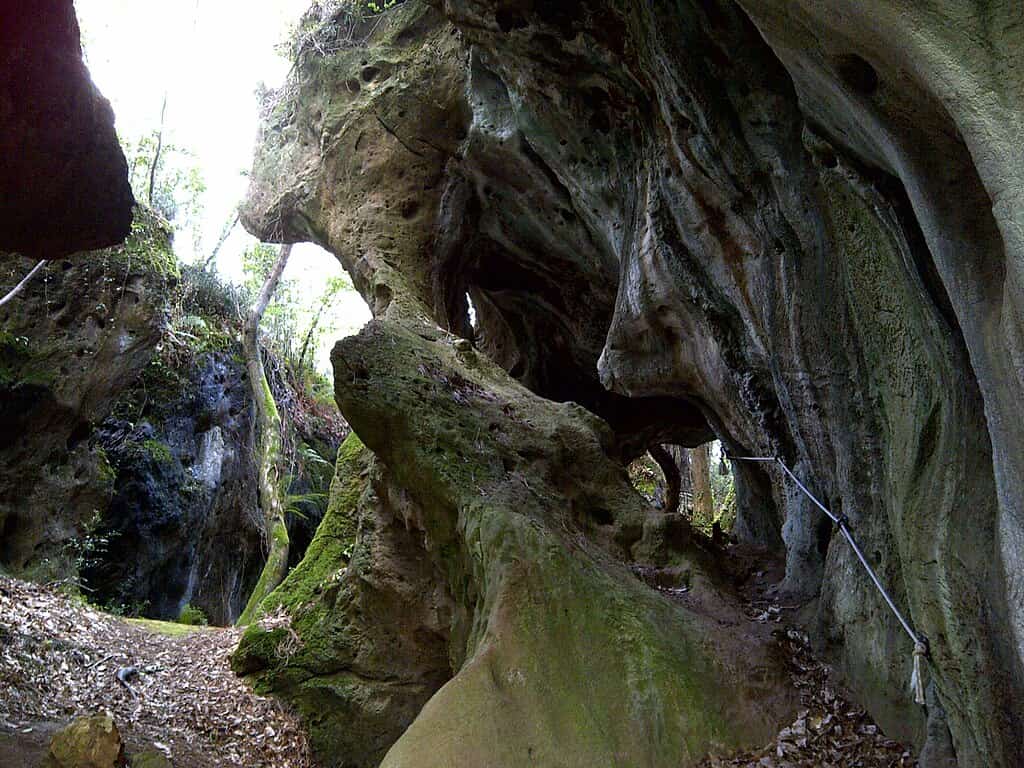
If time and energy allow, the surroundings of A Caridad offer natural landscapes of great beauty that are well worth a visit. Small detours reward the pilgrim with unforgettable views and moments of connection with pure nature.
- Puerto de Viavélez (3 km): this small and charming fishing port preserves the maritime essence of western Asturias. Its colourful houses, perched on the slopes, provide an idyllic scene, especially at sunset. It’s an ideal spot for a walk by the sea, to watch the boats and enjoy the sound of the waves crashing against the breakwater.
- Castro de Cabo Blanco (6 km): perched on a cliff, this ancient Celtic settlement offers a unique combination of history and landscape. From the top, you can gaze at the sea in all its splendour while exploring the remains of a pre-Roman culture that still retains some of its defensive structures.
- Playa de Porcía (7 km): surrounded by vegetation and sheltered by rocky formations, this beach is a peaceful haven. Its clean waters and natural surroundings invite relaxation.
- Cascada de Penadecabras (12 km): nestled in a wooded area, it surprises with its wild beauty. The sound of water falling among moss and ferns creates an almost magical atmosphere. Access is easy, and although the route is brief, it offers a deep connection with the purest Asturian nature.
- Covas de Andía (10 km): these natural caves, shaped by the action of water and time, create a curious and mysterious landscape. Exploring their nooks and crannies is a small adventure that allows you to closely observe the area’s geology and let your imagination wander.



